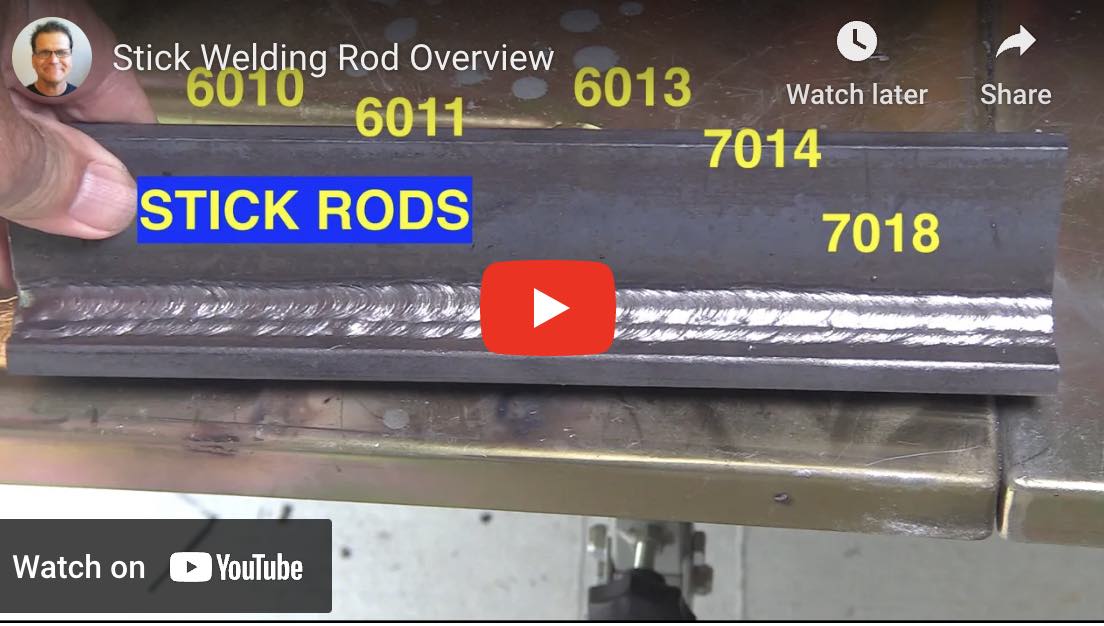Basic Stick Welding
- HOME
- STICK WELDING
- Basic Stick Welding
Basic Stick welding is pretty straightforward because the welding equipment is usually very simple.
No shielding gas is needed. And with inverter power sources being available that weigh less than 40lbs, Stick welding is very portable.
But just because the equipment is simple does not mean stick welding is obsolete or outdated.
Skill is important and it helps to have an understanding on what the main types of stick rods are for so the video below shows an overview of the most popular stick electrodes used for basic stick welding
- HOME
- STICK WELDING
- Basic Stick Welding
Stick welding takes practice but just like anything, once you get enough practice under your belt, something that seemed impossible at first gets much easier and you wonder why it seemed hard in the first place.
Basic Stick Welding with 7018
One thing that really helps when you are learning to stick weld is a good auto dark welding helmet.
Of course, back in the day, we used passive lenses and just learned to nod the hood down right before striking an arc but that is a skill in itself and to be honest with you my neck has taken a beating doing that for so many years before auto dark helmets came out.
Not trying to sell you one, but just saying your neck will thank you in 30 years if you get a good quality auto dark welding helmet.
A lot of pipe welders use a regular helmet or pancake hood with an auto dark insert for stick welding outside
Basic Stick welding rods and their uses
6010
- Description: High cellulose sodium electrode
- Uses:
- Deep Penetration: Ideal for welding in all positions and on welds requiring deep penetration, such as root passes in pipe welding ...both uphill and downhill
- Dirty or Rusty Surfaces: Effective on rusty, dirty, or painted surfaces.
- Pipeline and Structural Welding: Common in the oil and gas industry and for pipe welds.
6011
- Description: High cellulose potassium electrode
- Uses:
- Versatile: Can be used with both AC and DC currents. all position rod that can weld uphill or downhill
- Dirty or Contaminated Surfaces: Similar to 6010, good for welding on less-than-clean surfaces.
- Farm Equipment and Maintenance: Popular for repair work and maintenance welding.
6013
- Description: High titania potassium electrode
- Uses:
- Smooth, Aesthetic Welds: Produces a smooth weld bead with a soft arc, making it suitable for sheet metal and general fabrication.
- Light to Medium Penetration: Ideal for thin to medium thickness materials.
- Home and Hobby Welding: Common for DIY projects and light fabrication.
versatile rod that runs off AC or DC
- Drawbacks - easy to trap slag and get wormholes if improper amperage or rod angle is used
7014
- Description: Iron powder, titania electrode
- Uses:
- Higher Deposition Rate: The iron powder in the coating increases deposition rate, making it good for higher productivity.
- Smooth, Aesthetic Welds: Produces smooth welds with good appearance.
- General Fabrication: Suitable for general purpose welding on clean, new metal and structural steel where low hydrogen 7018 is not specified
7018
- Description: Low hydrogen, iron powder electrode
- Uses:
- High Strength Welds: Provides strong, ductile welds with excellent mechanical properties.
- Low Hydrogen Content: Minimizes the risk of cracking, making it ideal for critical welds in structural steel and pressure vessels.
- Clean Materials: Best used on clean, prepared surfaces.
- Construction and Heavy Equipment: Widely used in construction, bridges, and heavy machinery manufacturing.
7018 is the bread and butter rod for structural welding in the USA.
7018 is also frequently used for pipe welding uphill and is also sometimes specified for open roots on higher strength steel pipe welds. This is not a new thing but 7018 is much less common for root passes than 6010 generally speaking.














